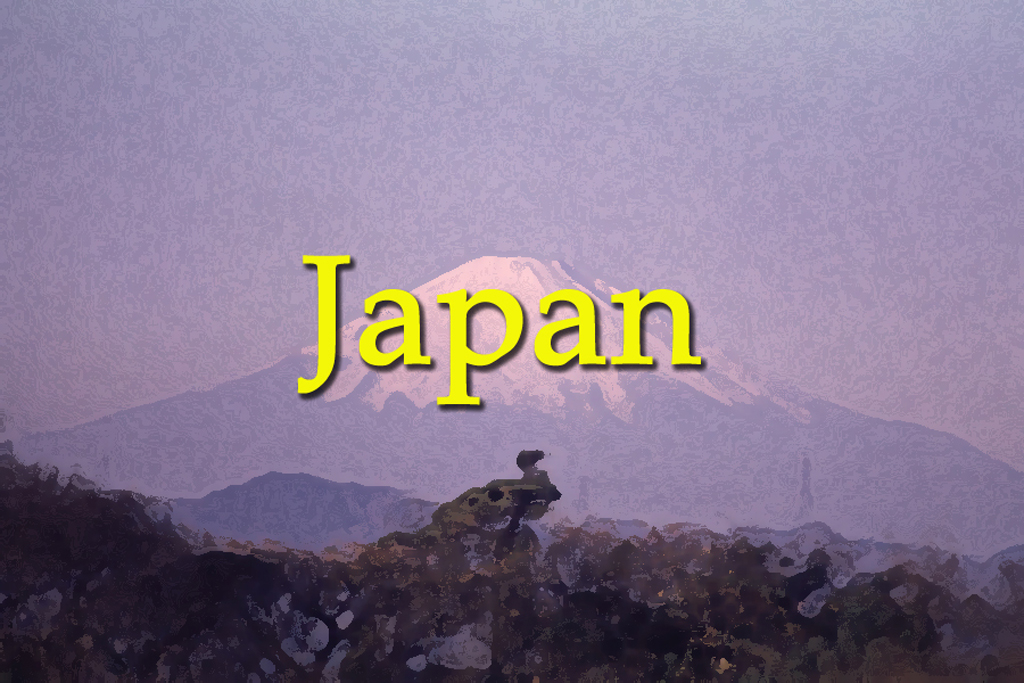When the USS Oklahoma City sailed into Tokyo Wan after a long cruise we were coming home. Yokosuka was our home port, and the closest thing we had to home off the ship. It was a sailor's town, with a bar district that catered to the crews of the ships that docked at the Navy base. But it was also an ordinary Japanese city, with a population of about 200000, with businesses that catered to the Japanese and a number of industries. Sailor town was just a small part.
Yoko had been the home of the Imperial Japanese Navy, and the base had an impressive collection of drydocks and ship support facilities. There was a large supply depot and an Armed Forces Hospital. The hospital served casualties from the Korean War and it was a treatment center for severely wounded soldiers from Vietnam. The Japanese built a huge underground headquarters facility that would have survived an atomic bomb attack. This served as headquarters for US Forces in Japan. There was a very nice Officers' Club, an Enlisted Mens' Club, a great Base Exchange and many recreation facilities.
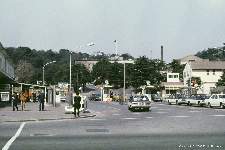
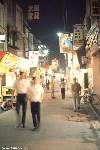
However, if you ask any sailor who visited Yoko what it is they remember the most, it will be Honcho. Japanese cities are divided into many areas called "chos," and Honcho was the "number one" or main downtown area. The main gate of the Navy Base opened out into Honcho, and this is where the action was. In the late 1960s, at the height of the Vietnam War, the streets were lined with many dozens of bars, cabarets and night clubs of just about every description that catered to servicemen. Mixed in with these were restaurants, hotels, local shops, pachinko parlors and souvenir stores. As far as sailor towns go it was pretty respectable. Unlike many other places we visited, in Yoko we were safe to indulge in our pleasures with no danger greater than being separated from a few dollars. Yoko was fun!
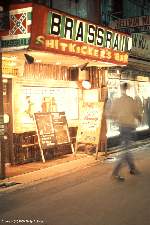
Each bar had a character of its own, though they all looked pretty much alike. Some played rock'n'roll, others featured country and western, and some had big band and jazz music. Most had dance floors, and all had a bevy of attractive hostesses. All served beer, cocktails and wine, but the liquor and wine were mostly Japanese, and, to be polite, not very palatable. Kirin and Asahi beers were the mainstay, along with soft drinks. It was the job of the hostesses to make the conversation lively and keep the beer flowing. In Japan the job of hostess was an acceptable, if not fully respectable, profession. It was part of the "Floating Society" that included bar tenders, artists, musicians and other entertainers, culminating at the top with the geisha, the ultimate entertainer. Hostess was the bottom rung of the ladder. Of course, in addition to their hostess duties some of the ladies were available for more private forms of entertainment. But their main job was to keep the sailors happy and spending money in the bars.
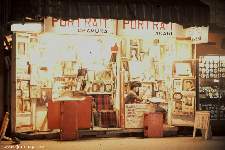
There was the Brass Rail (the sign read "A good bar, but not a great bar"), the Bar Cherry, the Texas, Cabaret 2nd New Yokosuka ("Here is no VC, just yen grabbers"), the Caravan, Honky Tonk, St. Louis, Rancho, Cupid, the US Club, and The Ruby, which was something entirely different. In between were tailor shops, hardware stores, book stores and artists' stands where you could get your portrait painted for mom, or have your girlfriend's head painted onto the body of the Playboy playmate of the month. Some shops specialized in patches for uniforms and jackets, and unofficial ships baseball caps. There was a little of everything in Honcho. If you wanted to take in local culture you could visit regular Japanese bars like the Hamburger, where you could play "matchi" for drinks against a very talented bar tender, or the Hollywood where you could join in the latest group dances with the Japanese kids.
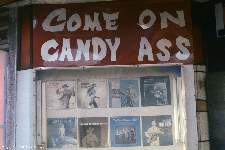
When new ships pulled into port the bars would put up signs welcoming the sailors from the ships. "Welcome USS Midway" or "Welcome USS Buttercup" would be posted within hours of the ship's arrival. All except the Okie Boat. We were home ported in Yoko, and for a while we were the only US ship home ported there. The Okie Boat sailors had already chosen their favorite establishments so there was no point wasting a sign trying to lure them in.
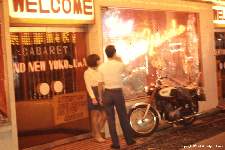
There was one occasion when new signs did appear for the OK City, more or less. One night several of us JOs had been out to dinner and a night on the town and were headed back to the ship. We hailed a taxi to drive us to the pier, but one fellow was pretty sloshed and had to be helped into the car. The driver asked "Where to?" and before anyone else could answer the inebriated fellow piped up with "Benjo Maru!" This started us all laughing, and not the least the driver. In Japanese "maru" means ship, loosely translated to "floating city," and "benjo" means sewer or toilet. "Benjo Maru" wasn't the most flattering name for a ship. We laughed at this impromptu christening all the way back to the ship. I might not have thought of that incident again except the next night many of the bars had signs out front welcoming the "Benjo Maru." The name caught on with Okie Boat sailors, some of whom also called the ship the "Shitty City". Benjo Maru was a Japanese name for this most Japanese of US Navy ships, and was used lightheartedly and not as a derogatory term. At least not always. A few weeks later the ship's hull was being painted at pier side, and one evening a well lubricated sailor climbed over the stern and down to the floating scaffolding. There, unnoticed in the dark, he proceeded to paint the name "Benjo Maru" in large black letters across the stern of the ship. This action did not go over well with the Captain and XO when it was discovered the next morning.
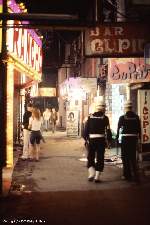
We had a variety of places to eat in Yoko. Just outside the Main Gate was Wimpys, where you could get a "hot dog ona stick." There were many restaurants outside of Honcho that catered mostly to Japanese, but we were always welcome. The Bonchi was a great restaurant that had a large semi-circular tepanyaki grill where the chef cooked your meal right in front of you (it wasn't the silly juggling act you get at Benihana's). I remember an especially rollicking night in the place when about ten of us had an informal "hail and farewell" party for the ship's legal officer, who was departing, and the new ship's doctor, who was just joining the ship. We rented a private dining room upstairs and had a great sukiyaki dinner. A lot of sake flowed that evening and a good time was had by all. The hostess who prepared the meal was very good at keeping the conversation going, and she wondered about the occasion. We explained that the legal officer was departing, and with a little effort got across the meaning of "legal" - I think the fellow knew enough Japanese to explain that he was a lawyer. But we were having a difficult time explaining "doctor." None of us knew the Japanese word, especially the doc who was the new kid in town. Finally he said he knew how to explain, and held up his hand with the index and middle fingers extended, as if he was going to perform a pelvic examination. The woman understood immediately, and exclaimed "Ah so! Skibby Doctor!" "Skibby" isn't in my Japanese dictionary, so I think it was a transliteration of "skivvy," a common term for sailors shorts. We all laughed so hard that our sides hurt. From that night on the doc was known as "Two Fingers."
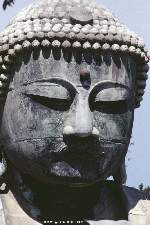
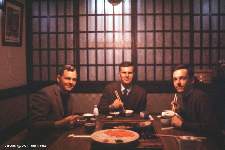
We didn't spend all of our liberty time in Honcho. Japan was a great place to visit. It had a public/private transportation system that was (is) a century ahead of the US. I could walk down the ship's brow and hail a taxi without waiting more than a minute. The taxi would take me to Yokosuka Station where I could catch the private line north to Tokyo or the Japanese National Railway west to Kamakura. From any train station in Japan you had connections to just about every part of Japan, and the trains ran frequently and on schedule. From Tokyo Station you could catch the high speed "Bullet Trains" to the more distant parts of the country, or the subway that crossed and circled the city. When you arrived at your final destination taxis waited at the stations to take you anywhere. We traveled all over the county for a tiny fraction of the cost of an automobile. Whether it was New Years in Kamakura (along with six million other visitors to Daibutsu that day), dinner in Tokyo, Expo 70 in Osaka or a few days in Kyoto, it was a very simple matter to get there. It was wonderful!
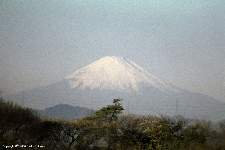
I must keep my description of liberty in Japan brief. I have many hundreds of photos, but it takes a long time to scan them and remove decades of dust and scratches from each one in Photoshop. Each picture on these pages required 30 minutes to an hour to clean up and adjust colors, brightness, etc. Maybe someday I will create an Okie Boat liberty page showing highlights of our visits to dozens of places in Asia. For now I will end with the view of Fuji san from a hill on the Navy Base in Yokosuka.

